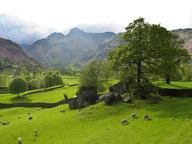Quiz Answer Key and Fun Facts
1. The two highest mountains of England are Scafell and Scafell Pike, which sit next to each other. Which of the following is not a route between Scafell and Scafell Pike?
2. The pillar of rock known as 'Eskdale Needle' or 'The Steeple' lies on the slopes of which fell?
3. Which fell rises behind (to the north) of the attractive and popular Tarn Hows?
4. Crinkle Crags is a series of five summits on a ridge. The lowest (although still over 2,500 feet) of the five is the most northerly. What name is given to this crinkle?
5. On which fell, which has the alternative name 'Bessyboot', may the body of water called "Tarn at Leaves" be found?
6. The northernmost peak of the Scafell Range is Great End. Which of the following is not a gully on the north facing rock buttress of Great End?
7. Wastwater Screes is a bank of scree alongside Wastwater. This name is sometimes applied to the entire mountain above it. What is the correct name for this mountain?
8. West of the Duddon Valley and south of the Hardknott Pass, Wainwright includes only two fells in his guide. One of these has crags named Demming Crag and Kepple Crag, which fell is this?
9. On which hill may Oak Howe Needle be found?
10. To who, whom or what did Alfred Wainwright dedicate book 4 of his 'Pictorial Guide to the Lake District'?
Source: Author
paper_aero
This quiz was reviewed by FunTrivia editor
Exit10 before going online.
Any errors found in FunTrivia content are routinely corrected through our feedback system.
